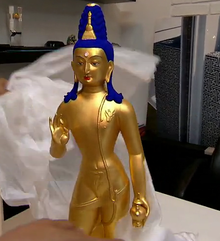Maidar City
| Maidar City | ||
 Visualization of Maidar City |
||
| Country: |
|
|
| Aimag : | Tow | |
| Founded: | 2014 | |
| Coordinates: | 47 ° 40 ' N , 107 ° 7' E | |
| Removal of UB | ||
| Beeline: | 30 km | |
| Time zone: | UTC + 8 | |
|
|
||
Maidar City , also called Maidar Eco City, is an urban development project approx. 30 km as the crow flies south of the Mongolian capital Ulaanbaatar (located in Töw-Aimag , Sum Sergelen). The design of Maidar City comes from Cologne architect Stefan Schmitz . Once completed, the city will accommodate 280,000 residents.
Surname
The word Maidar refers to the Buddha Maitreya , the Buddha of the future. According to the ideas of the planners, the future city should - in accordance with the spirit of Matreya - follow the principles of ecological urban development. The main goals of the urban design are sustainability, low CO 2 emissions, environmental protection and social harmony .
Project description
The aim of the project is to relieve Ulaanbaatar, which can no longer cope with the influx of nomads .
A central complex that is currently under construction with a Buddha statue - which will be 54 meters taller than the New York Statue of Liberty - forms the center of the new city , which is to be planned according to high ecological standards and certified according to German standards .
The most important design idea is the “city of short distances”. The city, the planned area of which is 114 km², will be divided as a whole into different parts of the city, each of which will function autonomously as a city within the city. The distribution of functions and the transport system are designed in such a way that the use of private cars can be largely dispensed with. The main routes in the city are the so-called “urban arteries” - streets that are intended exclusively for pedestrians, cyclists and public electric vehicles. They connect the centers of the individual city districts with one another and are designed without intersections with the roads of motorized traffic. The most important utilities in the city are located at the “urban arteries” and can be reached a maximum of 600 m from the residential buildings. The city districts are separated by landscaped green areas that are used for leisure activities, sport and recreation and stand in contrast to the characteristic hills and mountain tops that have been left in their natural state.
The areas south of the city will be used for agricultural purposes, which will extend south over the years and stop the advance of the Gobi Desert . These areas are primarily used for self-sufficiency in the new city.
The energy supply of the new city comes largely from renewable energies . A wind turbine with a capacity of 1.5 MW is being expanded east of Maidar City.

After completion, Maidar City will take over the function of a capital. The plans for a new parliament building in Mongolia already exist.
Timing
The central complex with the Buddha statue started in the summer of 2014. The plans originally assumed the entire project would be completed by 2024. The completion of the first district for 90,000 residents by 2030 was reported later. Only the foundation for the Buddha statue had been completed by summer 2019. No other construction work can be seen so far at the construction site. In view of this, the timely completion of the project seems questionable.
Web links
- WDR Weltweit: How a city is created , documentation on the urban development project
Individual evidence
- ↑ a b c d Maidar Eco City. 2013, accessed November 30, 2014 .
- ↑ a b Maidar City. (No longer available online.) Stefan schmitz bda architects and city planners, archived from the original on December 26, 2014 ; Retrieved November 30, 2014 . Info: The archive link was inserted automatically and has not yet been checked. Please check the original and archive link according to the instructions and then remove this notice.
- ↑ a b Land in Maidar City. (No longer available online.) Invest in Mongolia, archived from the original on December 5, 2014 ; accessed on November 30, 2014 (English). Info: The archive link was inserted automatically and has not yet been checked. Please check the original and archive link according to the instructions and then remove this notice.
- ↑ Project website , accessed on January 9, 2016
- ↑ a b Metropolis Maidar City. Cologne architect designs a metropolis in Mongolia. Kölner Stadt-Anzeiger from November 24, 2014, accessed on November 30, 2014 .
- ↑ a b How a city is created , at www1.wdr.de , accessed on January 9, 2016
- ↑ City of Visionaries in Frankfurter Allgemeine Sonntagszeitung from December 25, 2016, page 56
- ^ B. Batchimeg: Maidar city calculated to have 100 thousand residents by 2030. In: Montsame - Mongolian News Agency. February 27, 2019, accessed June 21, 2019 .

